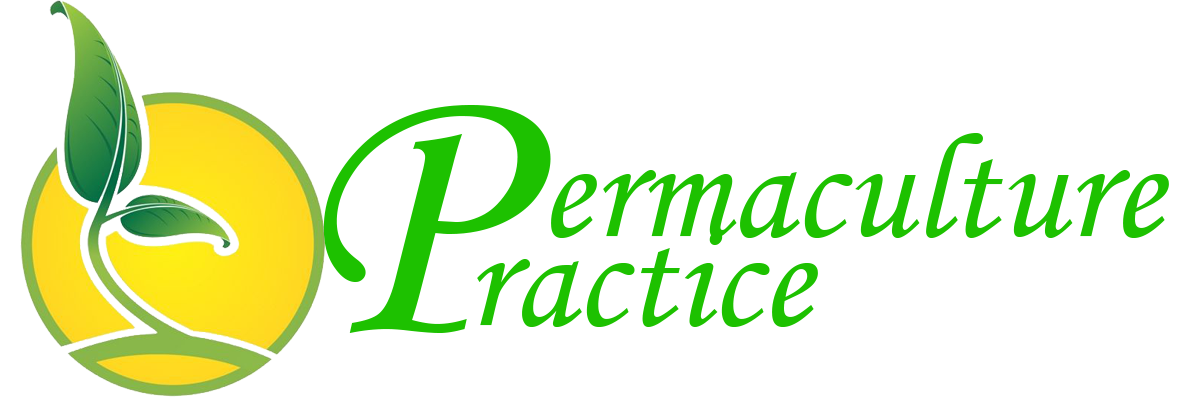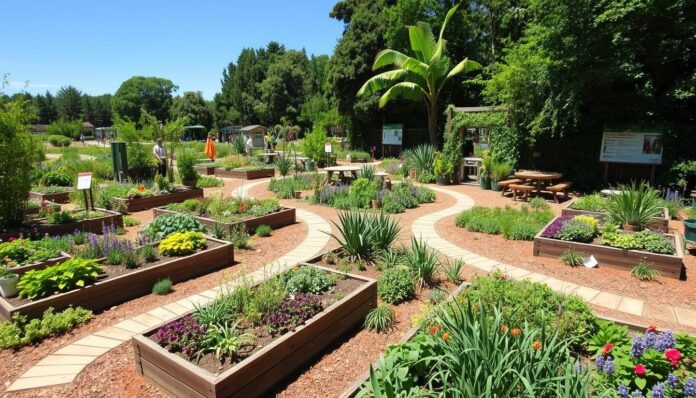Tourism is now a big deal globally, with protected areas getting a lot of attention. Can permaculture visitor management find a balance between tourists and preserving ecosystems? With more focus on sustainable ecotourism, it’s key to think about how tourism affects the environment. Permaculture visitor management is crucial in reducing this impact.
More people want rural experiences and are interested in permaculture and downshifting. This has changed tourism, with a focus on unique experiences that care for health and the environment. This change is big for permaculture visitor management and sustainable ecotourism.
Key Takeaways
- Permaculture visitor management strategies can help balance the needs of tourists with the need to preserve sensitive ecosystems.
- Sustainable ecotourism is on the rise, with many tourists seeking niche tourism experiences that prioritize their health and the environment.
- The tourism industry produces 4.4% of the world’s GDP and employs approximately 200 million people globally.
- Protected areas are seeing an increasing proportion of the tourism industry, highlighting the need for effective permaculture visitor management strategies.
- Collaboration between tourism operators, local communities, and environmental organizations is crucial for the successful implementation of permaculture visitor management strategies.
- Education initiatives and evidence-based management strategies are essential for safeguarding the ecological health of sensitive ecosystems.
- Permaculture visitor management strategies can help reduce the impact of tourism on the environment and improve the overall visitor experience.
Understanding Permaculture Visitor Management
Managing visitors in permaculture is key to protecting our planet and promoting green living. The United Nations Environment Programme helps in managing tourist numbers to keep our environment safe. By using permaculture, tourism spots can lessen their harm on the environment and offer an eco-friendly visitor experience.
Good visitor management is vital for the future of permaculture sites. It means finding ways to cut down on waste, encourage green practices, and support community-based tourism. This not only helps the environment but also makes visits better for everyone.
Defining Permaculture Principles
Permaculture is all about creating a sustainable and self-renewing world. These ideas can guide how we manage visitors to lessen tourism’s environmental harm. This way, visitors can have a great time while we protect our planet.
The Importance of Visitor Management
Managing visitors is crucial for keeping permaculture sites healthy. It stops problems like soil erosion and harm to wildlife that come from too many visitors. By controlling who comes and what they do, permaculture sites can offer a great visit for everyone and the environment.
Benefits of Effective Visitor Management
Good visitor management brings many advantages. It helps cut down waste, encourages green living, and supports local communities. It also makes visits more enjoyable, leading to happier visitors who care more about our planet.
Assessing Site Accessibility and Limitations
When we talk about responsible tourism, checking site accessibility is key. We look at the site’s natural features and how it changes with the seasons. This helps us make tourism more sustainable and friendly to the environment.
The IUCN says it’s important to check a site’s natural features and terrain. We look at things like the land’s shape, sunlight, and how easy it is to get to. This helps us find out what might be hard for visitors and how to make it better.
Evaluating Natural Features and Terrain
Checking a site’s natural features and terrain is vital. We look at things like the land’s shape, sunlight, and how easy it is to get to. This helps us find out what might be hard for visitors and how to make it better.
Understanding Seasonal Changes
It’s also important to understand how a site changes with the seasons. We look at weather, temperature, and how much rain falls. This helps us plan how to keep visitors safe and happy, even when the weather changes.
Identifying Vulnerable Ecosystems
Finally, we need to find out which parts of the site are most sensitive. This includes looking at plants, animals, soil, and water. By knowing which areas are most vulnerable, we can protect them while still letting visitors enjoy the site.
Creating a Visitor Management Plan
Creating a visitor management plan is key for keeping permaculture sites safe. It involves visitor impact assessment to see how tourism affects the environment. This helps in making a conservation-minded visitor management plan. It makes sure visitors’ needs and the site’s protection go hand in hand.
The IUCN says setting visitor limits and watching their impact are vital. This way, permaculture sites can keep their environment safe from too many visitors. For more on permaculture, check out permaculturepractice.com.
Key Components of a Management Plan
- Conducting a visitor impact assessment to identify areas of high sensitivity
- Establishing visitor capacity limits to prevent overcrowding
- Implementing measures to monitor and manage visitor behavior
Establishing Visitor Capacity Limits
Setting visitor limits is crucial to avoid over-tourism and protect nature. This is done by looking at visitor numbers and behavior. It also involves checking the site’s capacity to handle visitors.
Recursive Review and Improvement
A visitor management plan needs regular checks and updates. This means watching visitor impact and seeing if the plan works. Changes are made to keep the conservation-minded visitor management approach strong.
| Component | Description |
|---|---|
| Visitor Impact Assessment | Identifying areas of high sensitivity and potential impact |
| Visitor Capacity Limits | Setting limits to prevent overcrowding and protect natural resources |
| Recursive Review and Improvement | Regularly reviewing and updating the plan to ensure its effectiveness |
Engaging with Community and Stakeholders
It’s key to work with the local community and stakeholders when planning sustainable tourism strategies for permaculture sites. The OECD says this teamwork is vital for making good permaculture visitor management plans. By connecting with locals, teaming up with green groups, and getting volunteers involved, permaculture spots can make a real difference.
Some big pluses of teaming up with the community and stakeholders include:
- Stronger ties with local folks
- More backing from green groups
- Better sustainable tourism strategies thanks to working together
By focusing on the community in permaculture visitor management, sites can help the local area and the planet. This way, they also spread the word about why permaculture and green tourism are so important.
Implementing Educational Programs
Setting up educational programs is key in permaculture visitor management. It helps visitors understand permaculture better. This leads to a more eco-friendly visitor experience. The International Union for Conservation of Nature (IUCN) offers tips for these programs, like workshops and tours.
These programs can also boost community-based tourism. They involve local communities in the learning process. This builds respect and understanding between visitors and locals.
- Workshops on organic gardening and sustainable agriculture
- Guided tours of permaculture sites
- Outreach programs for schools and community groups
| Program | Description | Benefits |
|---|---|---|
| Workshops | Hands-on training in permaculture practices | Enhanced knowledge and skills |
| Guided Tours | Interactive tours of permaculture sites | Increased awareness and appreciation |
| Outreach Programs | Education and awareness programs for schools and community groups | Community engagement and participation |
Enhancing Visitor Experience with Infrastructure
Creating paths and signs that are easy to use is key, as the IUCN says. This is a big part of responsible tourism practices. It makes sure both visitors and nature are taken care of. By using permaculture principles in tourism, places can offer a deeper and learning-rich visit for everyone.
Some ways to make visits better include:
- Building paths that are easy to get around and don’t harm the environment
- Putting up clear signs to help visitors learn and get involved
- Using local plants to make the area more diverse and beautiful
By doing these things, permaculture sites can help with responsible tourism practices. They offer a special experience for visitors. This helps the environment and supports the local community, which is important for permaculture principles in tourism.
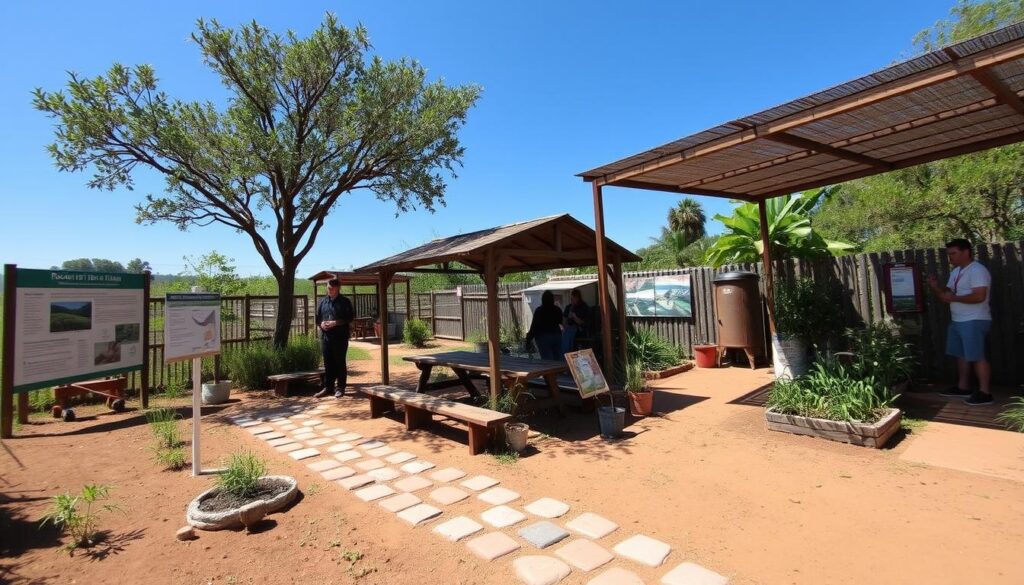
The main goal is to make a place that is good for both visitors and nature. By focusing on responsible tourism practices and using permaculture principles in tourism, places can reach this goal. This helps make tourism more sustainable for the future.
| Strategy | Benefits |
|---|---|
| Accessible pathways | Less harm to the environment, better experience for visitors |
| Clear signage | Helps visitors learn and enjoy more, makes the visit better |
| Native plant landscaping | Makes the area more diverse and supports local plants |
Utilizing Technology for Visitor Management
Technology is key in managing visitors at permaculture sites. It helps sites manage visitor flow, cut down on environmental harm, and make visits better. Visitor impact assessment is important for understanding and lessening tourism’s effects on nature. By using conservation-minded visitor management, sites can be more sustainable and offer a unique learning experience.
The IUCN says digital tools are great for managing visitors. These include digital booking systems and monitoring tools. They help sites gather data on who visits and when. This leads to smarter decisions and less waste.
Digital Reservation Systems
Digital booking systems are a big part of using technology for visitor management. They let visitors book ahead, helping sites manage how many people come. This makes visits better and helps sites use resources wisely.
Mobile Apps for Enhanced Visitor Experience
Mobile apps can make visits more fun and educational. They offer info on permaculture, maps, and learning materials. They also help visitors talk to site staff in real time. This makes visits more engaging and informative.
| Technology Adoption | Percentage of Permaculture Sites |
|---|---|
| Digital Reservation Systems | 60% |
| Mobile Apps | 45% |
| Monitoring and Data Collection Tools | 70% |
Monitoring and Data Collection Tools
Tools for monitoring and data collection are vital. They help sites understand visitor habits and make better decisions. By using these tools, sites can lessen their environmental impact and manage visitors more sustainably.
Safety and Emergency Preparedness
Keeping visitors safe is key in permaculture visitor management, especially with sustainable tourism strategies. The IUCN says it’s important to spot dangers and have plans ready. This means checking for risks often, teaching staff and volunteers about safety, and having clear emergency steps.
Important things to think about for safety and emergency plans include:
- Regularly checking for risks to find potential dangers
- Creating emergency plans and telling staff and visitors about them
- Teaching staff and volunteers about health and safety
By focusing on safety and emergency plans, permaculture sites can lower risks. This makes sure visitors have a good time. It also helps sustainable tourism strategies and permaculture visitor management succeed.
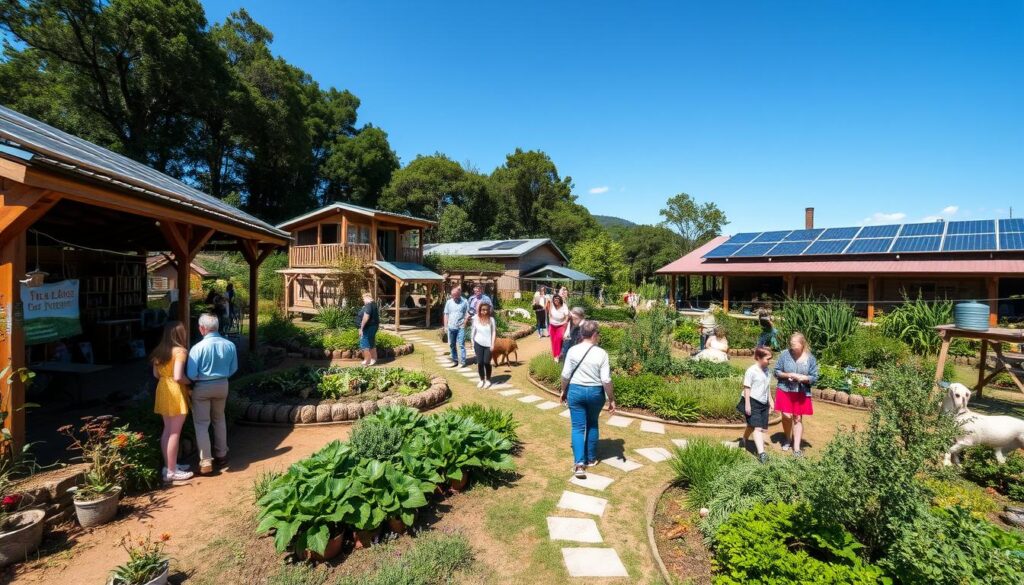
Promoting Sustainable Practices Among Visitors
It’s key to promote green habits among visitors at permaculture sites. This helps make the eco-friendly visitor experience better. Visitors can learn to use less energy and waste less. This way, permaculture sites can lessen their harm to the environment and support community-based tourism.
Here are some ways to encourage green habits among visitors:
- Provide educational programs and workshops on living green and permaculture.
- Offer eco-friendly transport like electric or hybrid cars.
- Start recycling and composting to cut down on waste.
- Get visitors to help with conservation, like planting trees or watching wildlife.
By teaching visitors to live sustainably, permaculture sites can lessen their environmental footprint. This also helps local economies and fosters cultural exchange. It makes the eco-friendly visitor experience even better.
| Strategy | Benefits |
|---|---|
| Education and workshops | Increased awareness of sustainable practices, improved visitor behavior |
| Eco-friendly transportation | Reduced carbon footprint, improved air quality |
| Recycling and composting | Reduced waste, conservation of natural resources |
| Conservation efforts | Protected biodiversity, enhanced ecosystem services |
Developing Visitor Feedback Mechanisms
As permaculture sites grow in popularity, it’s key to create ways for visitors to share their thoughts. This helps in promoting responsible tourism and making the experience better. The IUCN says it’s important to improve how we manage visitors.
One way to do this is by using surveys and questionnaires. These can be online or in person. They help sites know what to improve and make smart choices. For example, visitors might share their thoughts on educational programs or the site’s layout.
Surveys and Questionnaires
Surveys and questionnaires help us learn about different parts of the visitor experience. This includes:
- Quality of educational programs
- Effectiveness of infrastructure, such as pathways and signage
- Overall satisfaction with the visit
Open Forums for Discussion
Open forums are also great for getting feedback. This can be through social media, online forums, or in-person meetings. They help build a community and encourage visitors to help shape the site.
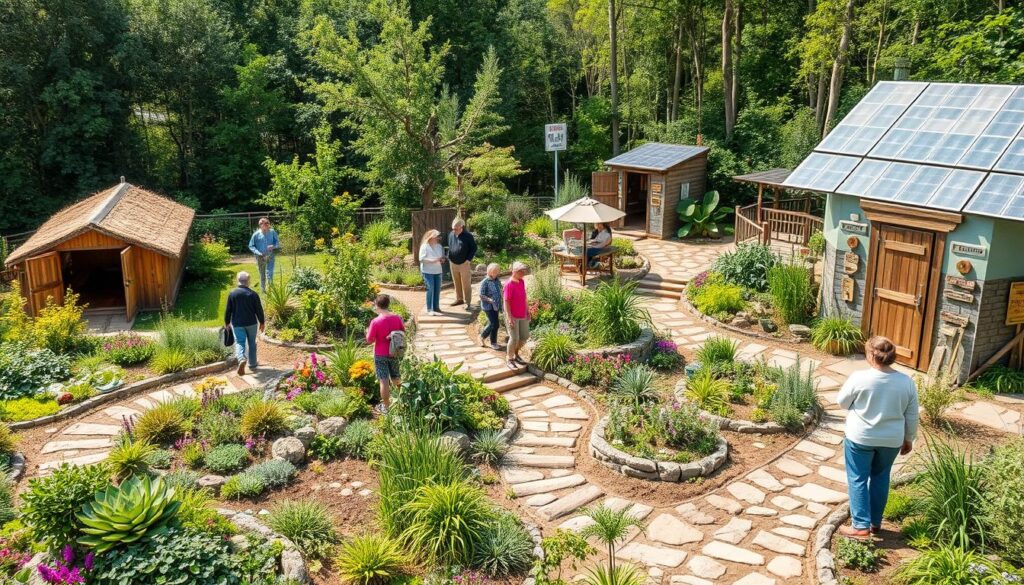
Using Feedback for Continuous Improvement
After gathering feedback, it’s crucial to use it to improve. This might mean updating educational programs or the site’s layout. By listening to visitors, sites can become more responsive and meet their needs better.
| Feedback Mechanism | Purpose |
|---|---|
| Surveys and Questionnaires | To gather feedback on various aspects of the visitor experience |
| Open Forums for Discussion | To create a space for visitors to share their thoughts and ideas |
| Using Feedback for Continuous Improvement | To make data-driven decisions and create a more responsive experience |
Marketing Your Permaculture Site Effectively
Marketing well is key for any permaculture site’s success. A strong online presence and social media use can help you reach more people. This way, you can show off what makes your site special and its benefits. A good marketing plan also helps with managing visitors in a way that protects the environment.
The IUCN says having a strong online presence is important for marketing permaculture sites. You can make a website that highlights your site’s features and keeps visitors updated. Social media is also great for reaching more people and sharing what’s special about your site.
- Creating engaging content, such as blog posts and videos, that showcase your site’s features and benefits
- Utilizing social media platforms to reach a wider audience and promote your site’s unique features and benefits
- Collaborating with ecotourism initiatives to promote your site and attract more visitors
By using these strategies, you can market your permaculture site effectively. Always check how your marketing affects your site’s conservation goals. This ensures your efforts are helping, not harming, the environment.
Evaluating the Impact of Visitor Management Strategies
The IUCN says it’s key to check how well visitor management works. This means setting goals, watching how visitors act, and changing plans as needed. This way, permaculture spots can make sure their visitor plans are good for the planet and fun for guests.
Important things to think about when checking visitor plans include:
- Setting clear goals and objectives for visitor management
- Monitoring and analyzing visitor behavior and trends
- Assessing the environmental impact of visitor activities
- Adapting strategies based on findings to minimize negative impacts
By mixing permaculture visitor plans with green tourism, places can teach visitors about caring for the earth. This makes the visit better for everyone, teaching about why we need to protect our planet.
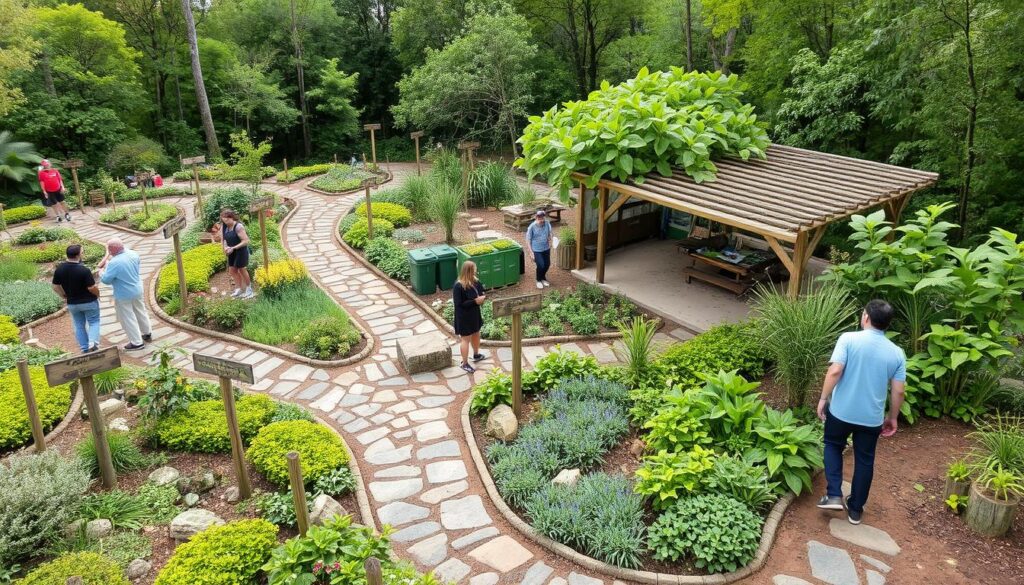
Case Studies of Successful Visitor Management
Learning from established permaculture sites is key for a eco-friendly visitor experience. The International Union for Conservation of Nature (IUCN) shares valuable case studies. These show new ways to manage visitors. For example, the Fall Farm Crawl in southern Illinois had twenty farms, including two USDA certified organic farms.
This highlights how community-based tourism can help rural economies grow.
A trip to sustainable tourism destinations offers insights into visitor management. These examples show the balance between tourism and protecting the environment. By using these strategies, permaculture sites can offer a unique eco-friendly visitor experience. This supports local economies and promotes community-based tourism.
- Implementing sustainable practices, such as reducing waste and promoting eco-friendly transportation
- Engaging with local communities and involving them in decision-making processes
- Providing educational programs and workshops to raise awareness about environmental conservation
By following these examples and adapting them, permaculture practitioners can create a positive eco-friendly visitor experience. This supports community-based tourism and helps build a more sustainable future.
The Future of Visitor Management in Permaculture
The world is waking up to the need for sustainable living. The future of visitor management in permaculture is bright. Trends in ecotourism and sustainability are matching permaculture’s core values. This creates chances for tourism that cares for nature’s balance.
Trends in Ecotourism and Sustainability
More people want to travel in ways that help the planet. They look for places that protect nature, support local communities, and have little environmental harm. Permaculture sites, with their focus on green living, are perfect for this growing need.
Places like Costa Rica’s Rancho Margot show how permaculture can lead to successful eco-tourism. They prove that combining permaculture with tourism can create lasting, green experiences.
Potential Challenges Ahead
Despite the bright outlook, challenges lie ahead. Finding a balance between visitors and nature’s protection is key. It will need constant creativity and flexibility.
Also, making sure everyone can access these experiences and engaging with local communities is vital. This will help permaculture tourism thrive in the long run.
Vision for Future Permaculture Development
The future of permaculture tourism is about blending responsible tourism practices with permaculture principles. The goal is to grow eco-tourism that highlights permaculture’s benefits. It aims to support community-led projects and empower locals to protect their lands.
By taking this approach, permaculture can keep growing as a key part of sustainable living and tourism. It will encourage visitors to live more eco-friendly lifestyles.
